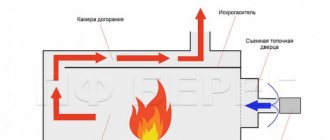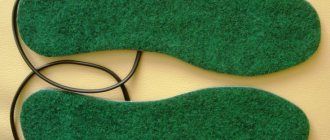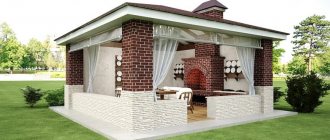Wood-burning samovar: modernizing a rarity
A wood-burning samovar is a symbol of hospitality, comfort, and the strength of family ties. If you live in a house, and even outside the city, a samovar just begs to be included in the interior. Yes, whatever it is in the interior, in everyday life or in holiday traditions that always hold the family together. A wood-burning samovar is a symbol of hospitality, comfort, and the strength of family ties. Homemade pastries, jam, and tea made with your own hands are not considered relics, but the samovar, which comes in handy in this “company,” is considered something long forgotten. Meanwhile, heating a samovar is not difficult, and even interesting; repairing it is also not the most expensive thing. Well, if there is nothing to repair yet, look for an interesting model in the store - new samovars are becoming fashionable.
Photo report “Samovar Master Class”
Shishmareva Nina Aleksandrovna
Photo report “Master class “Samovar”
History of the samovar for children
Before you create an interesting craft with your children, tell them about the history of the samovar . In this way, you will introduce your children to the national culture, help them broaden their horizons, and teach them to love their Motherland even more!
The samovar is designed to heat water. Hence the name of this word, which consists of two parts “self”
and
"var"
.
That is, he boils the water himself, as if he were cooking it. At the top of the samovar there is a recess where the teapot is placed so that this drink becomes even more fragrant and has time to brew under optimal conditions.
They say that the first samovar was brought by Peter I from Holland to Russia. But this is a legend. Since it is known that in Rus' this apparatus for boiling water appeared half a century after the death of the emperor.
Tea appeared in Russia at the end of the 16th century. In this regard, it was necessary to boil water for him. Therefore, the samovar became very popular in Russia.
But first, in the 18th century, there were sbitinki and kitchen samovars . Here they prepared sbiten from water, herbs, honey, and spices.
Tula is considered the birthplace of the Russian . Since these things began to be done here. But in documentary evidence you can find information that samovars began to be made at the Ural plant. The first unit was very large, weighing 16 pounds, and was made in the mid-17th century.
In the 19th century, the kerosene samovar . At this same time, 28 factories were already opened in Tula, where many of these popular household appliances were produced.
The shape of the samovar was different : ovoid, similar to an ancient Greek vessel. Travelers could take a small road model with them on a trip. She had removable legs. Such a samovar could be cubic or rectangular in shape.
In the 19th century, conical, smooth, faceted, spherical samovars .
, wood-burning samovars and cones powered by the network became popular You can plug them into a power outlet after first filling them with water, and quickly boil the liquid for making tea.
In Tula in 1922, a huge samovar weighing 100 kg and a volume of 250 liters was made. The water heated up in just 40 minutes and stayed hot for 2 days. Therefore, during this time it was possible to drink aromatic tea. This samovar was made of gold and presented to the politician Kalinin.
This is such a beauty we have!
The samovar and tea bowls are made from ceiling tiles, and the word “menu” is made from ice cream sticks. Everything is simple and accessible!
Musical lesson using ICT “There is steam above, steam below - our Russian samovar hisses” (preparatory group) Goal: Expanding and systematizing children’s knowledge about the traditional culture of the Russian people. Didactic objectives: Educational: consolidate.
Photo report “Master class for Mother’s Day for parents” If mom is nearby, the world is full of miracles, You don’t need anything if mom is here, I’ll take her hand tightly, I won’t give my mom to anyone in the world. (T. Frolova). Photo report “Master class from Katyusha” What a great summer! Isn't it true, dear friends? Some went to the sea, others to the mountains, and I met my beloved childhood friend. Photo report “To the House of Nature! To the master class! There is strength, power and strength in the Russian flag, It is a symbol for us, Dignity and honor. (E. Nikolaev) To the House of Nature! To the master class. Photo report about leisure time “The samovar is boiling, you won’t be bored!” Good day, dear colleagues! Today, the guys from our group “Cossacks” and I invite you to our themed leisure activity “Samovar”.
The project “What a miracle - a samovar” for preschool children of the preparatory group PROJECT “WHAT A MIRACLE - A RUSSIAN SAMOVAR” the project was compiled by Yulia Evgenievna Slizkaya, teacher of MBDOU No. 46 “Alyonushka” Relevance: Many holidays.
The Russian dance “Samovar” is performed to the song “Russian Samovar” by D. Tukhmanov. Performed by 6-8 girls and 1 “samovar” boy. The girls are in Russian sundresses, the “samovar” is voluminous.
Samovar. Craft for a competition This year, the guys and I took part in a competition for crafts made from waste material. Having familiarized ourselves with the position of the competition, we began to think. Do-it-yourself samovar with sweets “Come in for tea.” Photo report I bring to your attention this samovar with sweets inside. The idea came to me immediately, since I made this samovar as a gift for myself. Lesson “Miracle samovar” Miracle samovar Purpose: To introduce children to objects of ancient Russian life. Objectives: Educational: 1) Reveal the meaning of the samovar tradition.
Source
Charcoal and samovars in Tsarist Russia
In Rus' there was such a profession as a charcoal burner, and charcoal was sold in matting bags. Its main consumers were ferrous metallurgy and other industries, including food. But in the cities, charcoal was bought not only by blacksmiths and innkeepers. Samovars and ordinary people were heating up. Charcoal burners were so active in converting wood to charcoal that Tsar Alexei Mikhailovich was forced to ban this trade around Moscow in order to avoid complete deforestation.
How coal was made in the old days
It is interesting that the cause of black charcoal burners is still “living and winning” today. Although Tsar Alexei Mikhailovich was called the quietest, he called the coal burners to order quickly and for good. But near Kostroma, according to open sources, the prosecutor’s office and bailiffs have been struggling with the problem for years. And modern stoves for converting wood into coal keep smoking and smoking.
Private coal production. In an artisanal way, but on a large scale.
Craft from papier-mâché “Samovar”. Master Class
Olga Chicherova
Craft from papier-mâché “Samovar”. Master Class
A samovar in Russia is a household item; it is intended for heating water. It is not for nothing that the Russians, competing with the British, consider themselves perhaps the biggest tea lovers in the world. Our talented ancestors showed themselves here too; not content with a simple kettle, which was used in other European countries, they invented a samovar . The water in it boiled quickly and did not cool down for a long time, and everything was suitable for kindling: both wood chips and pine cones. Samovars became very widespread; they came in different shapes: round, square, cylindrical, cone-shaped. Samovars were skillfully decorated with various paintings. I bring to your attention making a samovar from papier mache . This samovar can serve as a visual and didactic material in educational classes, as well as in any type of activity, from theatrical to individual work. Enjoy watching.
It took me 5 days to make . For this craft you will need : a 9-liter plastic bottle, 2 rolls of toilet paper, 20 pieces of newspaper, flour paste, a stationery knife or scissors, a pan lid, wide and thin brushes, white and blue gouache, glue stick, colored paper ,colorless varnish (optional)
.
We take the bottle and cut off the top part, which will serve as a stand for the samovar .
the samovar will look like .
And now we coat samovar The last layer must be made of toilet paper.
Now we make blanks from plasticine of small parts (2 handles, a tap)
All parts are dried and cut, then glued together and dried again.
Now we tint it with white gouache and decorate it with elements of Gzhel painting. Decorated with the kids.
And this is the kind of samovar we got .
What to combine with a samovar costume
Under the bottom of such a suit, black or white clothes are worn . It is allowed to use items that match the main color or with decorative elements made from the same fabric as the base.
Shoes depend on the child's actions in the performance. If he needs to move a lot, then these should be Czech shoes of the same color as the bottom . They can also be decorated with fabric from the base. If dance numbers are not expected, then you can put the child in elegant sandals of the same color as the base.
A colorful detail can be beads made from bagels or dryers on the neck , and, of course, rosy cheeks .
History of the samovar for children
Before creating such interesting crafts with your children, tell them about the history of the samovar. In this way, you will introduce your children to the national culture, help them broaden their horizons, and teach them to love their Motherland even more!
Tell the children that the samovar is designed to heat water. Hence the name of this word, which consists of two parts “sam” and “var”. That is, he boils the water himself, as if he were cooking it. At the top of the samovar there is a recess where a teapot is placed so that this drink becomes even more fragrant and has time to brew under optimal conditions.
They say that the first samovar was brought by Peter I from Holland to Russia. But this is a legend. Since it is known that in Rus' this apparatus for boiling water appeared half a century after the death of the emperor.
Tea appeared in Russia at the end of the 16th century. In this regard, it was necessary to boil water for him. Therefore, the samovar became very popular in Rus'.
But first, in the 18th century, there were sbitinki and kitchen samovars. Here they prepared sbiten from water, herbs, honey, and spices.
Tula is considered the birthplace of the Russian samovar. Since these things began to be done here. But in documentary evidence you can find information that samovars began to be made at the Ural plant. The first unit was very large, weighing 16 pounds, and was made in the mid-17th century.
In the 19th century, the kerosene samovar was invented. At this same time, 28 factories were already opened in Tula, where many of these popular household appliances were produced.
The shape of the samovar was different: ovoid, similar to an ancient Greek vessel. Travelers could take a small road model with them on a trip. She had removable legs. Such a samovar could be cubic or rectangular in shape.
In the 19th century, conical, smooth, faceted, spherical samovars appeared.
After the invention of electricity, wood-burning samovars and mains-powered samovars became popular. You can plug them into a power outlet after first filling them with water, and quickly boil the liquid for making tea.
If you tell children about the samovar, then tell them an interesting fact. So, in Tula in 1922 they made a huge samovar weighing 100 kg and volume 250 liters. The water heated up in just 40 minutes and stayed hot for 2 days. Therefore, during this time it was possible to drink aromatic tea. This samovar was made of gold and presented to the politician Kalinin.
These are the interesting facts you learned about the Russian samovar before you started making it from various modern materials.
How to brew tea in a samovar: instructions for beginners
Finally, the most important thing is how to drink delicious tea from such a vaunted samovar. If you have no experience, you will have to read the instructions.
Before lighting the samovar, prepare a sufficient amount of wood chips
Lighting up a fire samovar:
- Place the samovar on a small table, it should be stable;
- Fill with water, close the lid;
- Light the wood chips and throw them into the jug, then add more wood chips (if the first one has not gone out);
- Place the pipe, let it flare up;
- Add wood chips until the water boils (the pipe, in turn, will create draft for combustion);
- At the very end, add herbs or the same cones for flavor;
- Pour tea into a teapot, pour boiling water over it and place on top of the samovar.
The tea should be tasty, aromatic, and the very atmosphere of such tea drinking is incomparable with automatic tea brewing from an electric kettle.
How to heat a samovar (video)
A fire samovar in your home or dacha is a necessary thing that will definitely decorate summer evenings and family or friendly gatherings. And the process of brewing tea itself is at the same time a pleasant ritual, which, like all good traditions, should be adopted from older generations.
How to make a samovar from paper tubes - master class and photo
If you have a lot of sheets of white stationery paper, then use it. Each sheet will need to be folded widthwise into three parts and cut. Then take a knitting needle and wind the tubes onto it.
In total you will need about 1000 pieces. You can involve everyone at home in this slow activity, and if you have the opportunity to do this during a break at work, then create them there.
If you wish, color the tubes. A stain of the desired color is suitable for this. Some of the tubes may turn out white, and others colored.
Varnishing crafts
To add sophistication to the samovar, it can be covered with stain, imitating valuable types of wood. You can varnish the product, matte or glossy, depending on your preferences. Choose a high-quality varnish; you can apply it with a brush or spray gun. Do not leave bubbles, lint or visible stains on the surface of the product.
You might be interested in the article: Varnishing crafts.
How to make a samovar from a thimble with your own hands?
Surprisingly, this handicraft item makes wonderful things, for example, samovars. Take:
Take two fittings and use pliers to shape them into handles. Then glue the blanks on both sides of the thimble. Take a coin, glue the grommet to it, on which the crown is pre-glued. Make two more decorations on this lid, these will be the tops of the nails and the fittings.
Bend the nail. This will be the nose. You also need to attach a bead here. To make the samovar stable, you will glue the crown and grommet down to it.
Transferring the template to plywood
In order to start cutting, you need to transfer the drawing to the workpiece, for this: Print the template in the required scale. Using tracing paper and a ballpoint pen to transfer the diagram onto the plywood. For convenience, secure the template with tape, buttons, or just your hand. Think about how best to arrange the elements of the samovar in order to save lumber. Take your time, your future product depends on the correctness and accuracy of the translation.
You might be interested in the article: Quick transfer of a drawing.
DIY candy samovar - master class
Here's how to make a samovar so that you can store sweets in it or create this product based on such sweets.
See how to create the basis for such a creation. Take foam plastic and cut out the following parts from it. The photo shows which ones.
Now see how to lay them out and how to glue them together. There will be both the base of the samovar and its lid.
Next you will need corrugated paper. Cover the workpiece with this material. Take the braid and decorate the seams with it. The beads will help make the legs of the samovar. Create a handle. To do this, take cardboard, roll this rectangle into a tube and glue the edge. Then paint this blank or also cover it with corrugated paper.
Insert beads into the tube from the sides and glue them. Take the wire, twist it so that you get these decorative elements. Pin them in place. The wire can also be painted or corrugated paper wrapped around it and glued. You need to glue the tape on both sides of the handles.
You can decorate the lid and the samovar itself with the same light braid. Now you can put candies inside to keep these sweets here.
And if you wish, then when deciding how to make a samovar, create it with sweets. You can give such a samovar as a gift and place it in your home in the most visible place so that you can admire it for the time being. When you want something sweet, you can eat a little candy. And if your loved ones come to visit, then you will put such an attribute on the table to everyone’s delight. And there will be a wonderful tea party.
To do this, you need to make a samovar, as in the previous case. Cover the created samovar with golden corrugated paper. Then start gluing identical semicircular candies here in two rows. It will make a wonderful craft.
How to choose a samovar: tips to note
If you are not going to hand over your existing samovar for repairs, or if you don’t have any samovar at all yet, you will have to buy one. There are also a lot of questions about how to choose. In order for the samovar to keep you happy for a long time, and for the tea to always be tasty, you need to choose carefully.
How to choose a fire samovar:
- External persuasiveness . The simplest thing is that there should be no dents or cracks, and there should be no uneven color.
- Sustainability . Place the samovar on a table or other flat surface; it should not wobble.
- Jug device . If this part is made of thin iron, quick repair of the samovar is virtually guaranteed.
- Tinning the inside . The inside of the product must be tinned with special food-grade tin.
- Tightness. Neither the faucet nor anything else should leak.
- Capacity. If there are at least three people in your family, then the volume of the samovar should not be less than three liters. There are smaller models, which are popularly called “egoist”, from which you need to drink tea in several approaches if you have a company.
Models with a corrugated surface are considered more stable.
DIY thread samovar
See how to make a samovar from yarn.
The product holds its shape thanks to a plastic mayonnaise bucket. It is inside. You can put various sweets here and then open the samovar and enjoy them.
First, take a hook and a ball, tie a circle whose diameter is equal to the bottom of the bucket. Divide the resulting number of loops by 4 and start adding evenly to create a fluffy part at the bottom.
Increase to the middle of the sides, then knit using the stitches you have. When you reach the top, start decreasing. As a result, you should get a circle equal to the diameter of your pot.
Use an awl to make indentations in the mayonnaise bucket in its upper part, secure this part with a thread.
Take a wire and wind yarn on one side of it. Do the same on the other side. But first you need to fix several beads in the center.
You will get handles like this. Insert the ends of the wire into the desired place in the samovar and secure them.
To make the samovar more fluffy, you can wrap the bucket with padding polyester, and then put it into the knitted part.
Now it’s time to crochet the lid using a crochet hook. It will also be semicircular. Make several holes in the lid of a plastic bucket and, using thread and yarn, sew it with a part of a samovar knitted from yarn.
To make the samovar stable, you can use a CD box as a stand. We need to tie it up.
To connect the samovar to this part, take a strip of cardboard, roll it into a ring and cover it with tape to secure it. Tie this piece with the same yarn. Decorate the samovar to your liking. You can make his eyes. And the nose will be a faucet. It must be made from a piece of wire. Insert it into the desired place, wrap it with thread. Here's how to make a samovar from yarn.
Cones for the samovar: brewing aromatic tea
The name wood does not mean that only firewood can be used. A fire samovar can be heated with coal, and if you want unusual tea, you need to heat it with cones.
It’s worth saying right away that you won’t find a better way than heating a samovar with charcoal. After coal combustion, not much ash is formed, and the resulting powder is easily removed.
But how, if you have a samovar, can you not brew tea using pine cones with your own hands? Indeed, it is worth drinking this tea at least once, but taking into account some nuances.
Firebox of a samovar with cones:
- Melting a samovar with them is not the best option, the soot will be considerable, but you can add it to the firebox while water is boiling;
- The cones contain a lot of resin, which tends to clog the inner pipe in the samovar;
- The cone should only be pine.
To ensure that the tea is not only aromatic but also healthy, only pine cones are used.
And here’s another curious fact: the water in the samovar will not come into contact with the burning fuel, but nevertheless, it will have the aroma of the wood that was used to melt the samovar. So your tea can be apple or pine. This is explained as follows: bubbles of active oxygen begin to form on the surface of the internal heating pipe during boiling. It turns out that the water in the samovar becomes, let’s say, alive.
Therefore, it is believed that tea from a samovar is special, soft, and the water for it has healing properties.
Charcoal is an unusual but useful gift
But what is officially and openly sold, you have every right to also openly buy. Finding out who produced it and how is the task of the police and the prosecutor’s office, not yours. Therefore, if you are going to visit the owner of a samovar or barbecue and don’t know what to give, feel free to buy a “gift” bag of charcoal!
Charcoal in a beautiful package will always be a practical and useful gift
In everyday life, charcoal was a waste product when burning a stove. Before closing the stove damper and the pipe view, the unburned coals from the hearth of the stove were swept out and placed in a tightly closed cast iron pot. Charcoal is very hygroscopic, and when stored in significant quantities it can spontaneously ignite, which is why it is stored in sealed metal containers.











